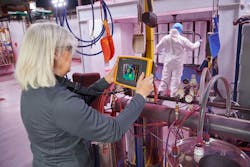That hissing sound you may—or may not—be able to hear in your plant could represent thousands of dollars from leaks in compressed air, gas, and vacuum systems evaporating into thin air.
It’s estimated that each year most plants waste as much as 30% of their compressed air production in unrepaired leaks. The result goes beyond wasted air pressure and energy and can lead to product quality issues (due to underperforming pneumatic tools) and unplanned downtime.
Playing Whack-a-Mole
Addressing compressed air leaks in a production facility is a bit like playing whack-a-mole.
Part of the reason air leaks are a big issue is that they are hard to find. Even when found and fixed, new leaks keep popping up—a fact of life due to wear and tear on equipment over time. But because it can be so difficult to find air leaks, most facilities just accept them as a cost of doing business. And while it may not be possible to eliminate all leaks, it is possible to substantially reduce their number.
The most common places to find air leaks are couplings, hoses, fittings, pipe joints, quick disconnects, condensate traps, and valves. That’s a lot to inspect and much of it is likely hard to reach. While maintenance staff does their best to fix the leaks they find during normal maintenance routes, most facilities don’t have the resources to dedicate specifically to this task. Technicians may make more of an effort to identify where a leak is located if a pneumatic tool isn’t working properly, but even then, it isn’t a trivial task.
Finding Leaks the Old-Fashioned Way
The most common leak detection methods involve listening for a hissing sound and then confirming with messy solutions of soap and water. But mostly, these outdated methods are time-consuming and typically effective at finding only the most obvious culprits.
The hiss and soap method: Most plants are extremely noisy and require workers to wear ear protection, so listening for leaks must be done during downtime—between shifts, on weekends, or during scheduled maintenance. When technicians suspect a leak, they spray soapy water on the suspected area to see if bubbles appeared. While the method worked for some leaks it was also time-consuming, tedious, and far from comprehensive.
The ultrasonic acoustic detection method: This method used a portable ultrasonic acoustic detector that captured leaks in frequencies beyond what the human ear can hear. This requires operators to wear earphones, use their experience and “educated ear” to determine what sounded like a leak, and swap between accessories for short and long distances. They started with a parabolic dish or cone-shaped accessory to detect a potential leak from a distance. Once a sound that may be a leak was detected, the technician switched to a wand-shaped device and moved within a few inches of the suspected area to pinpoint the exact location of the leak. This closeup inspection could rarely be done while machines were running.
Hear No Leaks? See Them Instead
Today, a new leak detection technology called sonic imaging has radically altered the leak detection process. Technicians can now instantly SEE air leaks.
This innovative technology is in a handheld sonic industrial imager that uses an array of tiny super-sensitive microphones to detect sounds both in the human hearing range and the ultrasonic range. The output is a visual representation of sound. Most users can get up to speed with the easy point-and-shoot imager in about 10 minutes, regardless of how little experience they have with leak detection.
Users simply scan the area of interest and the imager applies proprietary algorithms to the identified sounds. The result is an instant, visual map of the leak. The map is layered over a visible-light image of the area so users can quickly pinpoint the location of the leak and tag it or repair it on the spot. After repairing the leak, the user can use the sonic imager to instantly verify the repair. Scans can be saved as images or videos to be used as a reference for future discussions with colleagues or supervisors.
This sonic imager can visually scan large areas from more than 10m (33ft) in heavy noise conditions. This allows technicians to work very quickly and from a safe distance while equipment is running. It also makes it easier to find leaks in hard-to-reach areas, like behind equipment or in overhead pipes, and to distinguish between multiple leaks in the same area. The captured images eliminate the need to climb a ladder to tag the leak because the location of the leak is clearly identified in the image.
See Savings—in Energy and Dollars
Early results from production facilities that have started using the sonic imager validate the energy savings. One customer with a total installed capacity of air compressors equaling 330 ho has seen nearly a 26% recovery in compressed air capacity and close to $49,000 in annual electrical energy savings. Before using the sonic imager to inspect for air leaks, the plant ran four compressors close to full capacity. After a one-day inspection, the customer found and repaired more than 130 leaks. Now the facility can handle most of its compressed air needs with just three compressors. Since they were expanding the plant at the time, the fourth compressor will not go to waste and will save the company a capital expense.
The Future of Air Leak Detection Is Clear
Leaks will occur, but today there is a new, more comprehensive method for finding them. The simplicity of the sonic industrial imager means anyone can use it within 10 minutes. No more soapy water or hearing accessories necessary. Sonic industrial imagers are the practical and profitable method for facilities today, allowing air leak detection to easily be added to regular preventive maintenance routines.
